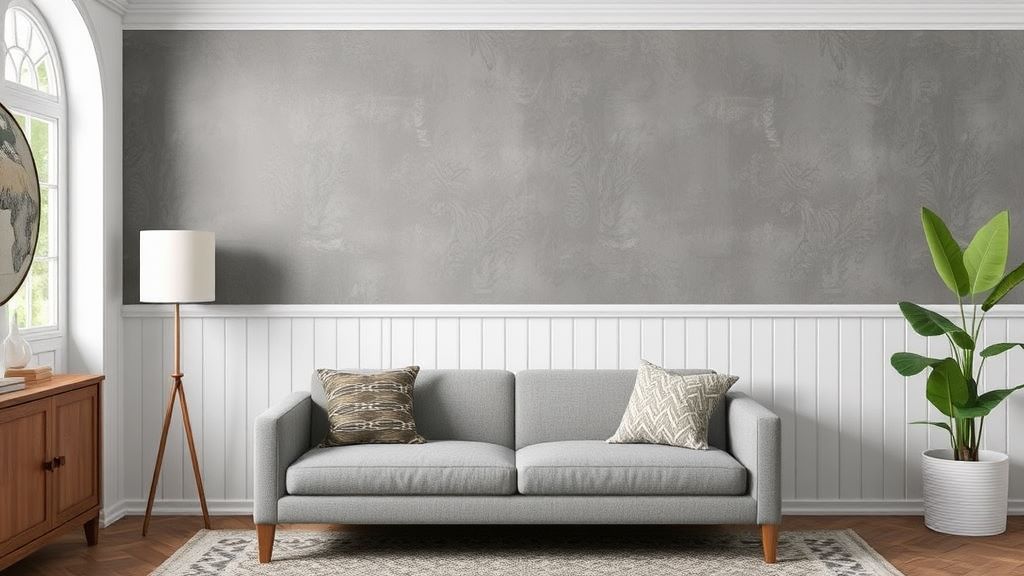
A beadboard accent wall can transform a plain room into a space full of character and visual interest. This classic design element, featuring vertical planks with ridges between them, brings a touch of cottage charm to any home. Let’s explore how you can use beadboard to enhance your space.
Why Choose a Beadboard Accent Wall?
Beadboard accent walls offer numerous benefits:
- They add texture and depth to otherwise flat surfaces
- Create a focal point in the room
- Are relatively easy and cost-effective to install
- Versatile enough to complement various decor styles
Whether painted in a bold color or left in its natural state, a beadboard accent wall can enhance bedrooms, living rooms, or even bathrooms. It provides a timeless appeal that never goes out of style.
Choosing the Right Wall
Selecting the right wall for your beadboard accent is crucial. Consider these factors:
- Size of the room
- Natural light sources
- Existing architectural features
- Purpose of the space
For instance, in a bedroom, you might choose the wall behind the headboard. In a living room, the wall behind the sofa could be ideal. Maximize the efficiency of your space by carefully considering the placement of your accent wall.
Preparing the Wall
Before installation, proper wall preparation is essential:
- Clean the wall thoroughly
- Remove any existing wallpaper or loose paint
- Fill holes and sand smooth any rough spots
- Apply a primer if needed
Taking these steps ensures a smooth surface for your beadboard installation. It’s similar to how you might prepare a surface for a new fireplace design.
Measuring and Cutting
Accurate measurements are crucial for a professional-looking result:
- Measure the wall height and width
- Calculate the number of beadboard panels needed
- Account for outlets and switches
- Use a saw to cut panels to size
Remember, measure twice and cut once! This precision is as important as when you’re designing a custom outdoor kitchen.
Installation Methods
There are several ways to install beadboard:
- Adhesive application
- Nailing directly to studs
- Installing over existing drywall
- Using a combination of adhesive and nails
Choose the method that best suits your skill level and wall type. Proper installation is key, much like when installing outdoor kitchen cabinets.
Painting and Finishing
Once installed, it’s time to add color:
- Choose a paint color that complements your decor
- Apply a primer if needed
- Use a roller for large areas and a brush for details
- Consider a protective clear coat for high-traffic areas
The right color can dramatically change the feel of a room, just as choosing the right color for kitchen cabinets can transform a kitchen.
Styling Your Beadboard Accent Wall
Enhance your new accent wall with these styling tips:
- Hang artwork or mirrors
- Add floating shelves for display
- Place furniture to highlight the wall
- Use lighting to emphasize texture
Your styling choices can create a cohesive look, much like when designing a coastal-inspired patio.
Maintaining Your Beadboard Wall
Proper maintenance will keep your accent wall looking fresh:
- Dust regularly with a soft cloth
- Clean with mild soap and water as needed
- Touch up paint when necessary
- Check for and repair any damage promptly
Good maintenance practices extend the life of your accent wall, just as they do for outdoor furniture.
Beadboard in Different Rooms

Beadboard can work in various spaces:
- Kitchens: As a backsplash or lower wall covering
- Bathrooms: For a classic, spa-like feel
- Bedrooms: To create a cozy atmosphere
- Living rooms: As a feature wall behind the TV
Each room presents unique opportunities, similar to how different outdoor spaces can be designed.
Combining Beadboard with Other Elements
Beadboard pairs well with other design elements:
- Wainscoting for a traditional look
- Shiplap for a farmhouse feel
- Crown molding for added elegance
- Textured wallpaper for contrast
Mixing elements can create a unique look, much like blending different design styles in outdoor spaces.
DIY vs Professional Installation
Consider these factors when deciding between DIY and professional installation:
- Your skill level and available time
- The complexity of the project
- Tools required
- Budget constraints
Sometimes, professional help is worth the investment, just as it is when installing complex outdoor features.
Beadboard Alternatives
If traditional beadboard isn’t quite right for your space, consider these alternatives:
- Faux beadboard wallpaper
- Beadboard-inspired tile
- Textured paint techniques
- Wood plank walls
These options can achieve a similar look, providing flexibility much like choosing different materials for outdoor kitchens.
Conclusion
Adding a beadboard accent wall is a fantastic way to infuse charm and character into your space. With careful planning, proper installation, and thoughtful styling, you can create a stunning focal point that enhances the overall aesthetic of your room. Whether you choose to DIY or hire a professional, the result will be a timeless addition to your home that you’ll enjoy for years to come.



